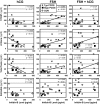Characterization of functionally typical and atypical types of polycystic ovary syndrome
- PMID: 19240152
- PMCID: PMC2684483
- DOI: 10.1210/jc.2008-2248
Characterization of functionally typical and atypical types of polycystic ovary syndrome
Abstract
Context: The typical polycystic ovary syndrome (PCOS) phenotype includes 17-hydroxyprogesterone (17OHP) hyperresponsiveness to GnRH agonist (GnRHag) testing. Functionally atypical PCOS lacks this feature.
Objective: The hypothesis was tested that the typical PCOS ovarian dysfunction results from intrinsically increased sensitivity to LH/human chorionic gonadotropin (hCG) due to a flaw in FSH action. PARTICIPANTS/DESIGN/INTERVENTIONS/MAIN OUTCOME MEASURES: After phenotyping a cohort of 60 women, steroid and inhibin-B responses to gonadotropins were evaluated in representative typical (n = 7) and atypical (n = 5) PCOS and healthy controls (n = 8). Submaximal hCG testing before and after an FSH test dose was performed in random order before and after prolonged ovarian suppression by depot GnRHag.
Setting: The study was performed at a Clinical Research Center.
Results: Of our PCOS cohort, 68% were the typical type. Typical PCOS had 17OHP hyperresponsiveness and, unlike controls, significant androgen and estradiol responses to hCG. FSH increased inhibin-B and did not inhibit free testosterone or enhance estradiol responsiveness to hCG, all unlike controls. After ovarian suppression, 17OHP, androstenedione, and inhibin-B responsiveness to gonadotropin testing persisted. Atypical PCOS had significantly higher body mass index but lower ovarian volume and plasma free testosterone than typical PCOS. Steroid responses to hCG were insignificant and similar to controls. FSH suppressed free testosterone but stimulated inhibin-B. The estradiol level after combined hCG-FSH was subnormal. Free testosterone was less GnRHag suppressible than in typical PCOS.
Conclusions: Typical PCOS is characterized by intrinsic ovarian hypersensitivity to hCG to which excessive paracrine FSH signaling via inhibin-B may contribute. Atypical PCOS is due to a unique type of ovarian dysfunction that is relatively gonadotropin hyposensitive.
Figures




Similar articles
-
Asymptomatic volunteers with a polycystic ovary are a functionally distinct but heterogeneous population.J Clin Endocrinol Metab. 2009 May;94(5):1579-86. doi: 10.1210/jc.2008-2771. Epub 2009 Feb 24. J Clin Endocrinol Metab. 2009. PMID: 19240158 Free PMC article.
-
Ovarian age-related responsiveness to human chorionic gonadotropin in women with polycystic ovary syndrome.J Clin Endocrinol Metab. 2004 Aug;89(8):3769-75. doi: 10.1210/jc.2003-031851. J Clin Endocrinol Metab. 2004. PMID: 15292303
-
Comparison of follicle-stimulating-hormone-stimulated dimeric inhibin and estradiol responses as indicators of granulosa cell function in polycystic ovary syndrome and normal women.J Clin Endocrinol Metab. 2006 Aug;91(8):2920-5. doi: 10.1210/jc.2006-0442. Epub 2006 May 23. J Clin Endocrinol Metab. 2006. PMID: 16720653
-
Interactions between androgens, FSH, anti-Müllerian hormone and estradiol during folliculogenesis in the human normal and polycystic ovary.Hum Reprod Update. 2016 Nov;22(6):709-724. doi: 10.1093/humupd/dmw027. Epub 2016 Aug 27. Hum Reprod Update. 2016. PMID: 27566840 Review.
-
Regulation of gonadotropin secretion: implications for polycystic ovary syndrome.Semin Reprod Med. 2002 Nov;20(4):317-26. doi: 10.1055/s-2002-36706. Semin Reprod Med. 2002. PMID: 12536355 Review.
Cited by
-
Determination of the source of androgen excess in functionally atypical polycystic ovary syndrome by a short dexamethasone androgen-suppression test and a low-dose ACTH test.Hum Reprod. 2011 Nov;26(11):3138-46. doi: 10.1093/humrep/der291. Epub 2011 Sep 9. Hum Reprod. 2011. PMID: 21908468 Free PMC article.
-
Disordered follicle development.Mol Cell Endocrinol. 2013 Jul 5;373(1-2):51-60. doi: 10.1016/j.mce.2012.07.011. Epub 2012 Jul 31. Mol Cell Endocrinol. 2013. PMID: 22874072 Free PMC article. Review.
-
Assessing hypothalamic pituitary gonadal function in reproductive disorders.Clin Sci (Lond). 2023 Jun 14;137(11):863-879. doi: 10.1042/CS20220146. Clin Sci (Lond). 2023. PMID: 37272254 Free PMC article. Review.
-
Hyperandrogenic origins of polycystic ovary syndrome - implications for pathophysiology and therapy.Expert Rev Endocrinol Metab. 2019 Mar;14(2):131-143. doi: 10.1080/17446651.2019.1576522. Epub 2019 Feb 15. Expert Rev Endocrinol Metab. 2019. PMID: 30767580 Free PMC article. Review.
-
Basal insulin-like factor 3 levels predict functional ovarian hyperandrogenism in the polycystic ovary syndrome.J Endocrinol Invest. 2011 Oct;34(9):685-91. doi: 10.3275/7726. Epub 2011 May 17. J Endocrinol Invest. 2011. PMID: 21586896
References
-
- Zawadzki J, Dunaif A 1992 Diagnostic criteria for polycystic ovary syndrome: towards a rational approach. In: Dunaif A, Givens J, Haseltine F, Merriam G, eds. Polycystic ovary syndrome. Cambridge, MA: Blackwell Scientific Publications; 377–384
-
- Rotterdam ESHRE/ASRM-Sponsored PCOS Consensus Workshop Group 2004 Revised 2003 consensus on diagnostic criteria and long-term health risks related to polycystic ovary syndrome. Fertil Steril 81:19–25 - PubMed
-
- Knochenhauer ES, Key TJ, Kahsar-Miller M, Waggoner W, Boots LR, Azziz R 1998 Prevalence of the polycystic ovary syndrome in unselected Black and white women of the southeastern United States: a prospective study. J Clin Endocrinol Metab 83:3078–3082 - PubMed
-
- Dunaif A 1997 Insulin resistance and the polycystic ovary syndrome: mechanism and implications for pathogenesis. Endocr Rev 18:774–800 - PubMed
-
- Norman RJ, Dewailly D, Legro RS, Hickey TE 2007 Polycystic ovary syndrome. Lancet 370:685–697 - PubMed
Publication types
MeSH terms
Substances
Grants and funding
LinkOut - more resources
Full Text Sources
Medical

